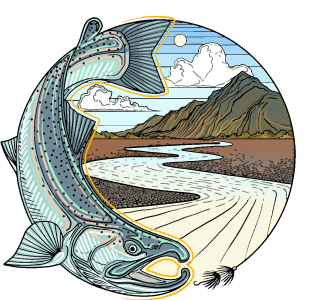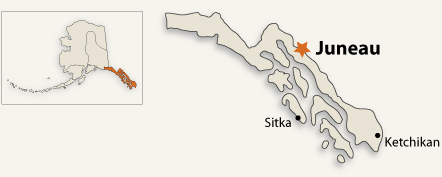The Interior Road System: The Big Picture
At the northern end of Cook Inlet lies Anchorage, AK, home to roughly half of the state's population. The Anchorage area is also the terminus of the road system that connects the interior Alaska communities to the "outside". For the most part, Alaska is a roadless area with access limited to boat or plane, but in the road system area, 4 major highways and several minor roads run right along many of the area's fishing destinations, often offering miles of access to lakes and streams. The road system area encompasses Anchorage to the south, Fairbanks to the north, Tok to the east, and Talkeetna marking the westernmost town.
Several hundred lakes are found within close proximity to the roads, and many of these have been stocked by the ADF&G to provide fishing opportunities. Many rivers also parallel or are crossed by the road system including several tributaries of the mighty Yukon river, as well as tributaries and mainstem flows of the Copper and Susitna rivers. All together, the road system provides access to over 200 fishable bodies of water, making it a prime area for the Alaska fly angler.
All 5 species of pacific salmon are present in the road system area, as well as rainbow and lake trout, Dolly Varden, grayling, sheefish, and northern pike. It is worth mentioning that the northern part of this region gets only king, coho, and chum salmon, and in fairly low numbers. Also, after having traveled over 900 miles in freshwater, these fish arrive in less than peak condition and are rarely sought out for sport. If salmon fishing is in your plans, it would be best to focus your efforts on the southern portion of the road system.
As with anyplace in Alaska that has seasonal abundance in the form of fish runs, brown bears often congregate in the area's river drainages in the summer and fall to feed with abandon on the yearly bounty of salmon. Fishing and camping around bears is not without its risks, and while salmon runs and fishing results can often be predicted, bears can not. The United States Forest Service (USFS) has a tremendous amount of information on traveling and camping safely in bear country, and we strongly recommend reading this and getting a clear understanding of the essential practices.
Fly Fishing the Interior Road System: When & Where
Spring: May
By mid-May, most lakes are either ice-free or well on their way to being ice-free. The warm spring sunshine and long daylight hours combine to produce great feeding conditions for rainbow and lake trout, as well as grayling and pike. Concentrate on lake-inlet and outlet streams using minnow patterns , sculpins and leeches .
May also signals the start of the Northern Cook Inlet king salmon run. Although the May fish can be few and far between, they are chrome bright and prized for their unadulterated fighting power. Fish the rivers near their saltwater terminus and concentrate your efforts after the daily high tides. In the northern end of the region, most lakes and rivers are ice-free by Memorial Day. Look for grayling and pike in sloughs and rivers and think minnow and leech patterns.
Summer: June and July
To the road system fly angler, June and July are the gravy days, with opportunities to pursue almost all of the areas' species at or near their seasonal peak abundance levels. Grayling fishing throughout the road system is going strong in June, and these scrappy fighters can be had on wet flies as well as dries. Nymphs such as the Hare's Ear, Delektable CDC Prince, and Flashback Pheasant Tail are good patterns to have, as well as dries such as the Salcha Pinkie and the Red Tailed Black Gnat.
On the Northern side of the road system, the rainbow trout and Dolly Varden fishery builds to a crescendo during the summer, as these predators mass in anticipation of the arrival of the salmon after their 900 mile journey from the sea. Beads and Unreal Eggs are the patterns of choice for summertime trout and dollies. The salmon run on the southern end of the road system is in full swing now, with all 5 species available during July. For kings, use big patterns such as the Foxee Prawn, the Fat Albert, and the Articulated Hareball Leech .
Sockeye can often be enticed with small, sparse patterns such as the Copper Swan and the Sockeye Lantern. Chums often respond aggressively to flies such as the Hot Shot Comet and the Egg Sucking Leech in hot pink. Small but scrappy, the pink salmon can often be enticed by slow-stripped Hot Shot Comets, Egg Sucking Leeches and Humpy Hookers in shades of pink and purple. Cohos begin building by late July, and will often chase flies such as the Purple & Pink Clouser Minnow and Hareball Leech in Pink. Lakes are still an option, although the dog-days of summer tend to drive the fish deeper in the water column to avoid the UV rays of the "Midnight Sun".
Late Summer / Fall: August and September
As summer fades into fall, the abundance of the early salmon run also wanes. Coho salmon are the bright spot in both the northern and southern regions of the road system, and their runs are building steadily through August to a peak in mid-September. Pink or Chartreuse Clousers, Coho Kryptonite, and Popsicles are all good choices for these hard fighters. Rainbow trout are also on the bite at this time of year. Try Peach Flesh Flies and Gorman Beadhead Eggs, and don't forget to have a well-stocked bead box.
Lake fishing is also picking up as the lakes cool off in the shortening days of late summer. Northern pike get more aggressive as the water cools, and will eagerly hit large offerings such as Barry's Pike Fly. Rainbow trout, lake trout, and grayling are all available as well during these cooler days. Look for shallow flats and lake inlets and outlets, and fish nymphs and dries for the grayling and rainbows, and streamers like the Beadhead Thin Mint or Olive Dolly Llama for the lake trout.
Fall: October
October brings the endgame for all but the diehard fly angler in the road system region. Generally, the northern end receives the first snowfall of the year during the first week of October, and that usually means that the water temperatures are rapidly dropping into the un-fishable range. The odd coho can be had in October in the northern area, but these fish can be few and far-between, and are probably best left to spawn in peace. In the southern area, some coho runs peak in late September-early October, and these can provide great sport for the warmly-dressed angler. Rainbows continue to feed in both streams and lakes, often right up to ice-in. The key to salmon and trout fishing in lower, colder water is to reduce both the size and speed of your offering, making it a more attractive target to your quarry. Try smaller flesh flies like Battle Creek Specials for trout and Neon Shrimp for coho. October also represents last casts for northern pike, as these fish feed right up until ice-in.






Leave A Comment